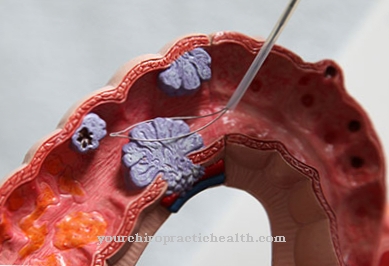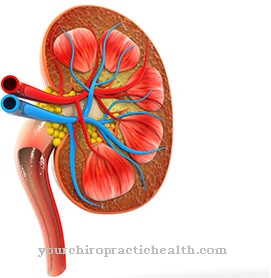In the event of violence, falls or sports accidents, humans can develop a Bruised eyeball come. While this is harmless for most patients, in other cases it can cause serious complications, so a bruised eyeball should be treated as soon as possible.
What is an eyeball bruise?

© bilderzwerg - stock.adobe.com
A contusion of the eyeball is to be understood as an injury in the area of the eyeball, which is also known as contusio bulbi in technical jargon and can have various causes.
A distinction is made between a slight and severe bruise of the eyeball and the rarely occurring tear. Symptoms of a bruised eyeball include a slight swelling in the area of the eyeball and conjunctival hemorrhage, which usually occurs and manifests itself in reddening of the conjunctiva.
Depending on the severity of the injury, the lens, retina or globe wall can also be damaged. In these cases, the patient should be referred to an eye clinic immediately, as complications such as cataracts or glaucoma as well as retinal edema and iris inflammation can occur.
causes
There are many different causes of a bruised eyeball. Mainly, however, the bruise of the eyeball is caused by strong effects of force in the area of the eyeball.
Injuries during exercise can also contribute to the development of a bruised eyeball. Here it is primarily ball sports such as tennis, squash or golf, in which the balls can hit the eyeball with a very high force.
Furthermore, a fall on the eye can also trigger a contusion of the eyeball. Bruises occur less often when foreign objects such as stones, wood chips or corks hit the eyeball at high speed in everyday situations.
You can find your medication here
➔ Medicines for eye infectionsSymptoms, ailments & signs
A contusion of the eyeball is characterized by pain and a temporary deterioration in vision. The impairment of vision depends on the severity of the bruise. Double vision may also occur at times. The eyelids turn red and swell. At the same time, the area around the eyes also swells.
Colloquially, the term "violet" is used. If the conjunctiva is also affected, some of the eyes can no longer be opened. In some cases, there may be bleeding inside the eye. As a result, the intraocular pressure may increase. A tear off of the iris, detachment of the retina, clouding of the lens or even a displacement of the lens are possible.
Furthermore, depending on the injury, fractures can also occur in the bony eye socket. The bottom of the eye socket breaks easily. This limits the mobility of the eyeball. This in turn also creates double images. In some cases, the muscle that is responsible for narrowing the pupil is damaged.
This means that the pupil is no longer round and the different incidence of light can no longer be adjusted. When the lens is involved, star-shaped cortical opacity often occurs. In general, the bruise of the eyeball is associated with severe pain and swelling, red and itchy conjunctiva. The more structures are destroyed, the more intense the pain and the longer it lasts.
Diagnosis & course
Depending on the affected parts of the eye, the symptoms and the course of a bruise differ. In most cases, however, there is always a swelling of the eyelids, which can be accompanied by severe pain.
In addition to this, the conjunctiva often also shows swelling and redness, which can be attributed to increased blood flow. Corneal edema also develops, and the intraocular pressure can be increased. In many cases a rounding of the pupil can also be found, which can be traced back to the injured iris sphincter, which normally controls the function of the constriction of the pupil.
In such a case, a correct reaction of the pupil to the incidence of light is no longer possible. If a contusion of the eyeball causes the orris root to tear off, double vision can also appear as symptoms of the injury. In severe cases, with the possible emergence of the optic nerve, a complete rupture in the globe wall occurs.
Complications
In most cases, a bruised eyeball does not cause any further discomfort or complications. The symptom should still be treated by a doctor, as the eye is a very sensitive organ that can be easily damaged. Often a swelling of the eye occurs after a bruised eyeball.
This can be cooled and in most cases goes back by itself after a few hours. The increased blood flow makes the eye appear red, which is also a common symptom. It is not uncommon for the eyesight to deteriorate briefly after the eyeball has been bruised and vision can be blurred or double vision can occur.
However, as long as these symptoms disappear within a few hours of the bruise, no medical treatment is necessary. A bone fracture may occur in the event of a serious accident or hitting the eye. This must be treated immediately in an eye clinic. If the retina is also damaged when the eyeball is bruised, this can lead to permanent visual disturbances.
In most cases these can be corrected with the help of a laser. Often the symptoms only appear a few days after the bruise of the eyeball. If the patient is not sure whether a symptom is dangerous or not, a doctor should always be consulted so that the bruised eyeball does not cause consequential damage.
When should you go to the doctor?
A doctor should always be consulted after falls or sports accidents. In particular, injuries to the eye such as a bruise in the eyeball require medical treatment, otherwise serious complications can occur. For this reason, it is advisable to go to the doctor or hospital immediately if the eyeball is bruised. If the eye bleeds profusely or is painful, it is best to call an emergency doctor.
Ambulance help is particularly necessary in the event of visual disturbances or even loss of sight on the affected eye. Conjunctival bleeding and swelling of the eyeball should also be treated quickly. If you have a serious eye injury, you must go to the eye clinic immediately.
There, the intraocular pressure is first stabilized and then appropriate treatment - usually a surgical intervention or laser operation - initiated. If a seam opens after the treatment or the eyeball starts to bleed again, the responsible doctor must be spoken to. Visual disturbances such as blurred vision or double vision must be clarified immediately in an eye clinic.
Doctors & therapists in your area
Treatment & Therapy
Appropriate therapy should be started as soon as possible after the occurrence of a bruised eyeball. Therefore, the problem has to be presented relatively quickly in an eye clinic or ophthalmic practice, in which the increased intraocular pressure is first counteracted by medication.
Based on the severity of the injury, a decision is made as to which form of therapy is most suitable for recovery from the bruise. For example, if there is an injury to the retina, it is usually removed by laser surgery. Even if the eyeball is torn, an operation must be carried out as soon as possible and the patient then given antibiotics to prevent infections in the area of the eyeball.
If there is a bone fracture in the eye socket, this is usually corrected by surgery after an X-ray diagnosis. Metal bone plates are used to counteract the damage. In the case of small injuries to the fundus, an examination is usually only required after about 7 days, as in this case the symptoms do not appear until some time after the incident. In order to prevent possible consequential damage, constant follow-up examinations are also required in all cases.
Outlook & forecast
The prognosis for a bruised eyeball is strongly linked to the severity of the bruise. A slight bruise in this area, which recedes within hours and does not leave any discomfort, deserves a significantly different consideration than, for example, a bruise in the eyeball that is accompanied by a crack.
The prognosis is good in the case of a slight bruise (reddening of the eye, temporarily slightly changed vision). Normal vision will return and the eye will heal again. Nevertheless, an ophthalmologist should be consulted, as in rare cases even minor injuries and those that are overlooked can lead to serious complications.
In more serious cases, the speed of medical examination and treatment is crucial. A torn or detached iris, an injury to the pupil, etc. can usually be corrected surgically. Usually there are no long-term effects to fear.
This is different if the optic nerve has been damaged (tears or bruises in this area) or the macula ("yellow spot") has been affected. This can lead to tears or bleeding, for example. Injuries to the optic nerve and the fundus in most cases mean permanent impairment of visual acuity and can also result in blindness in the affected eye.
In addition, late effects (retinal detachment, cataract, etc.) are possible, which is why the eye should be examined regularly. Headaches due to problems with the adjustment of the pupil occur after such an accident.
You can find your medication here
➔ Medicines for eye infectionsprevention
It is not very easy to specifically prevent an eyeball bruise. Merely wearing protective goggles when doing woodwork or similar activities helps, for example, to shield the eye from foreign objects and thereby prevent possible bruising of the eyeball.
In the car, seat belts and airbags protect against bruises. Furthermore, the use of force should be avoided in all situations and the respective game balls should be handled as carefully as possible during sport.
Aftercare
A bruise of the eyeball can occur in different degrees of severity, so that in particularly severe cases a follow-up examination is essential. Often a slight to moderate bruise on the apple is accompanied by severe discoloration around the eye. If pressure is applied to the affected area, the person complains of very uncomfortable pain.
If the eyeball is severely bruised, it may even cause a fracture. In such a case, regular visits to an appropriate doctor are very important and meaningful. This is the only way to ensure and guarantee that the fracture will grow together properly. Even in the later healing process, subsequent visits to the doctor are mandatory.
Many affected people strain the area too soon, so that it can break open repeatedly. The point in time when the affected area is 100 percent resilient can only be determined with an appropriate follow-up examination. Mild to moderate bruises usually go away completely on their own.
However, if the bruise is severe, regular examinations should take place. Only in this way can unnecessary complications and unexpected complaints be recognized early and treated accordingly. If such examinations do not take place, permanent consequential damage may occur that cannot be cured 100 percent afterwards.
You can do that yourself
Since the eye is an extremely sensitive organ that can be easily damaged, a bruise should always be examined and treated by a doctor. In parallel to the medical treatment, the patient can observe a few self-help tips to promote the recovery of the eye.
After a bruised eyeball, there are usually unpleasant symptoms such as swelling of the eye, a red eye due to increased blood circulation and blurred vision. Cooling the eye area is recommended so that the swelling of the eye can decrease again. Cooling pads, cooling gel pads or chilled cucumber slices are a quick remedy.
Placing cooled tea pads on the eye can also have a positive effect on the swelling. The tannins contained in the pads stimulate the metabolism of the lymph glands and subsequently reduce the swelling of the inflammation. In most cases, the swelling will go away on its own within a few hours.
The medicinal plant arnica is also recommended for treating bruises, as it is anti-inflammatory and analgesic. By wearing protective goggles, the eye can be shielded from dangerous external influences in order to prevent further bruising of the eyeball.

.jpg)
.jpg)









.jpg)



.jpg)










.jpg)
